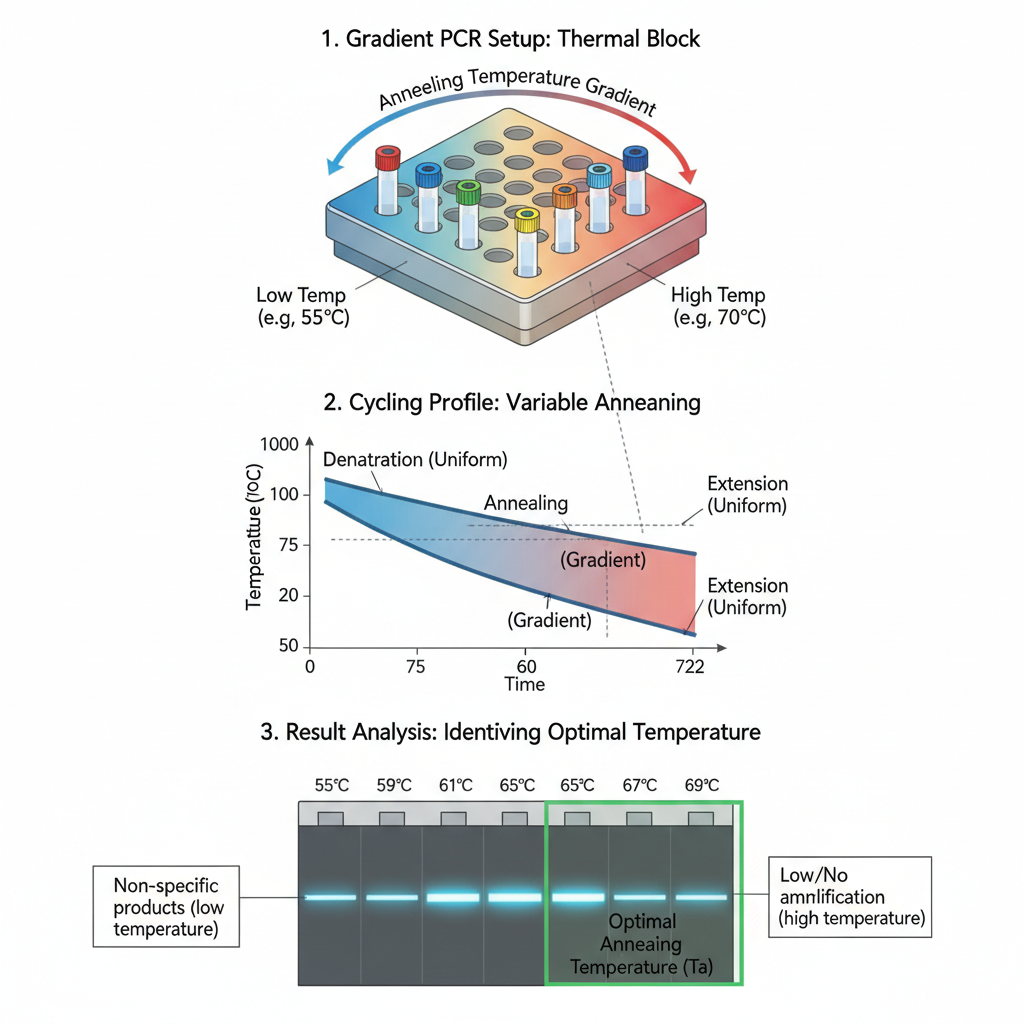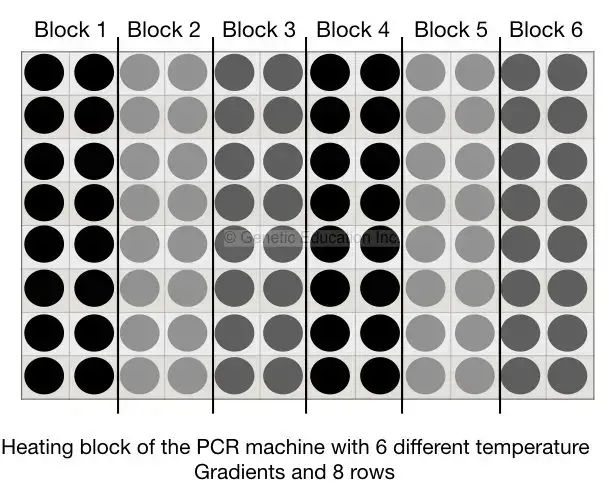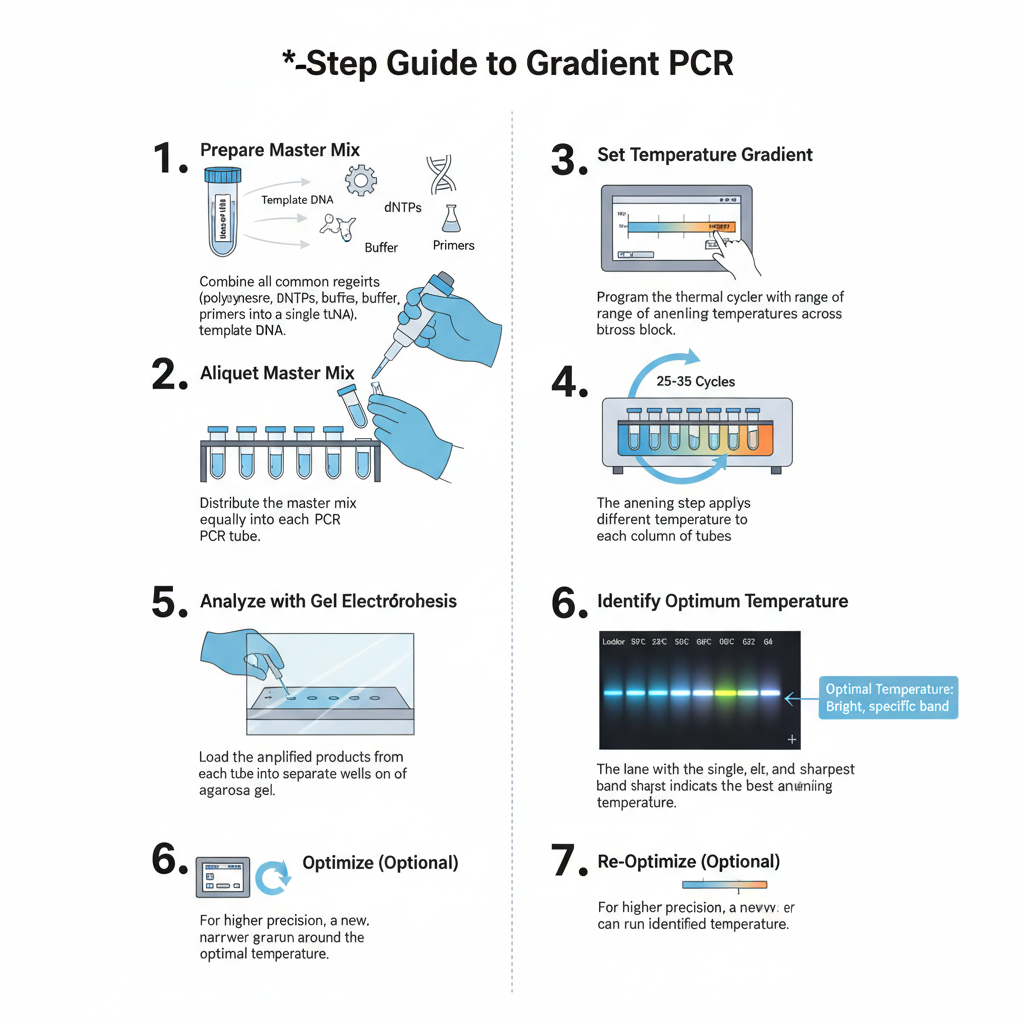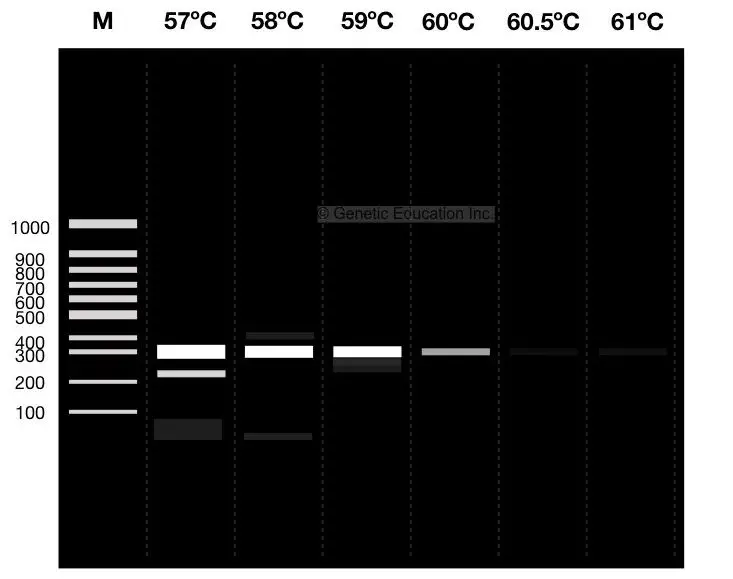Gradient PCR is referred to as a PCR optimization method where a range of annealing temperatures is tested at the same time in a single run.
It is done in a thermal cycler that contain a gradient block, and this block is made in such way that one side hold lower temperature while the opposite side hold higher temperature, creating a smooth spread of heat across the wells. It is the process in which each tube experience a slightly different annealing condition, so the researcher can see at which temperature the primers bind most correctly with the target DNA.
This technique is used because even if the primers have a calculated Tₘ, the real annealing temperature is often not same as many factors like buffer, polymerase and template type influence the binding.
It is the method that save reagents and time since many temperatures is checked in one experiment instead of running several separate PCRs. The best amplification pattern, usually a single clear band without smear or primer–dimer, is selected as the optimal Tₐ for that primer pair.
Definition of Gradient PCR
Gradient PCR is a specialized molecular technique that allows for the simultaneous testing of different annealing temperatures in a single PCR run, optimizing the conditions for precise DNA amplification.
Principle of Gradient PCR
The principle of Gradient PCR is based on creating a controlled temperature spread across the thermal block so that the annealing step occur at different temperatures in the same run. It is the process in which denaturation and extension stay uniform, but the annealing temperature is changed gradually from one side of the block to the other, forming a linear temperature gradient. This gradient allow the primers to bind with different strengths depending on the local temperature, so each tube show how the primer–template pairing behave under slightly altered conditions. It is considered important because primer binding is highly sensitive to heat, and even small changes decide whether specific or non-specific products are formed. The reaction is therefore observed across the gradient to identify the temperature that give the most accurate amplification. It is also noted that the components like MgCl₂ or template type influence the annealing behaviour, but the gradient makes it easier to find a stable condition without running many separate PCR programs.

How to use gradient PCR?

1. Preparation of Master Mix
It is the first step where all common reagents is mixed in one tube. These are DNA polymerase, dNTPs, reaction buffer, MgCl₂, primers, template DNA and water. It is advisable to prepare slightly more volume because some loss occur during pipetting. This is referred to as preparing a uniform mixture so that every tube receive the same components.
2. Aliquoting of Master Mix
The prepared mixture is divided equally into several PCR tubes. In this step, each tube contain identical reaction components. The only change in the later step is the annealing temperature. It is important that all tubes receive the same reaction volume.
3. Setting the Gradient in PCR Machine
The gradient thermal cycler is now programmed. It is the machine that provides different temperatures across the block. The annealing temperature range is selected (for example 50°C to 65°C). The high and low temperature is entered, and the cycler automatically distributes the intermediate temperatures. The denaturation and extension temperature remain the same in all wells.
4. Running the PCR Cycles
The reaction is placed inside the thermal cycler. The program usually include initial denaturation, repeated denaturation, annealing and extension steps. The annealing step is the one where gradient temperature is applied. These cycles is repeated for around 25–35 times depending on the protocol.

5. Gel Electrophoresis of Products
After completion, the amplified products are examined on agarose gel. The reaction is run against a DNA ladder. The purpose is to see which tube produced the sharp, single and bright band. In this step, the specificity of product can be understood easily.
6. Identification of Optimum Temperature
The tube that produce the best band represents the correct annealing temperature. The band must be bright, without non-specific bands or smearing. This temperature is used later for all further PCR reactions using the same primer pair.
7. Re-Optimization (Optional)
If the best band is located at the extreme end of the temperature range, a narrower gradient is set again around that temperature. This process occur when more precise annealing temperature is required.



Advantages of Gradient PCR
- It is the method that allow several annealing temperatures to be tested in one run, so the process become fast and less time is required for optimization.
- It helps in quick identification of the correct annealing temperature which is important for getting specific product.
- It reduces the use of reagents because many conditions is examined together instead of preparing separate reactions.
- It is considered cost-effective as the same master mix is used for multiple temperature conditions.
- It increases the specificity of amplification since the best temperature is easily identified where primer binding is most accurate.
- It is useful when new primers is tested because the gradient help in checking which temperature give the clean band.
- It produce robust reaction conditions which remain stable even when small variations occur in reagents.
- It can also be used to study other factors like MgCl₂ concentration or polymerase performance by creating a simple 2-dimensional setup.
- It is helpful in troubleshooting when no product is formed, as incorrect annealing temperature can be detected quickly.
- It is used in complex assays where strict temperature control is required such as multiplex PCR.
Limitations of Gradient PCR
- The gradient range in most machines is limited, so only a small temperature difference is obtained in one run.
- It cannot explore very wide temperature intervals when primers have large variation in melting temperature.
- The equipment is costly and many laboratories may not have access to gradient cyclers.
- The initial setup is sometimes difficult because the programming of temperature columns need careful adjustment.
- In some machines, the temperature across the block is not completely uniform, so small variations can affect the result.
- It mainly optimize the annealing temperature, while other components like MgCl₂ or enzyme concentration is not directly adjusted in the same run.
- Some reactions that are highly sensitive may require additional conditions which gradient PCR alone cannot provide.
- The method still face problems of contamination and non-specific products if the reaction is not handled properly.
Applications of Gradient PCR
- It is mainly used for finding the correct annealing temperature because different temperatures is tested in one run and the temperature giving the best and specific product is identified.
- It help in developing new PCR assays since the gradient gives quick information about how primers behave at different temperatures.
- It is useful when calculated Tm values does not match the practical condition, so the actual working temperature is determined experimentally.
- It can be used to study other reaction components by arranging a simple 2-dimensional setup where temperature vary in one direction and reagent concentration vary in the other.
- It allow checking MgCl₂ concentration, primer amount, and enzyme performance together with temperature screening.
- It is helpful when templates have high GC content because slight change in denaturation temperature can improve strand separation.
- It is used in multiplex PCR where several primers with different annealing temperatures must work at the same time.
- It supports genotyping and mutation detection because high specificity is required to differentiate small sequence changes.
- It is useful for difficult templates such as long fragments, high GC templates, or degraded DNA samples.
- It can improve RT-PCR efficiency when primers or reaction conditions need precise temperature adjustment.
- It is also used for troubleshooting when no product is formed, because it can show whether the problem occur due to wrong annealing temperature.
- It help in identifying the temperature that remove non-specific bands or smearing when several unwanted bands appear.
- It can be used to confirm if contamination is present by checking temperature at which unwanted fragments fail to amplify.
Quiz
What is the primary purpose of Gradient PCR?
a) To amplify DNA fragments
b) To determine the optimal annealing temperature for primers
c) To sequence DNA
d) To visualize DNA on a gel
Which component’s optimal concentration can be determined using Gradient PCR?
a) dNTPs
b) Primers
c) MgCl2
d) All of the above
In Gradient PCR, what does the term “gradient” refer to?
a) Gradient of DNA concentration
b) Gradient of enzyme concentration
c) Temperature gradient across the PCR block
d) Gradient of primer concentration
How does Gradient PCR enhance the efficiency of PCR optimization?
a) By reducing the reaction time
b) By allowing simultaneous testing of multiple annealing temperatures
c) By increasing the DNA yield
d) By reducing the primer concentration
Which of the following is NOT a benefit of Gradient PCR?
a) Time-efficiency
b) Cost-efficiency
c) Ability to sequence DNA
d) Reduced non-specific amplification
In a Gradient PCR machine, what allows for different temperature zones?
a) Different heating blocks for column pairs
b) Varying primer concentrations
c) Different dNTP concentrations
d) Varying enzyme concentrations
What is the typical range for testing annealing temperatures in Gradient PCR?
a) 45ºC to 55ºC
b) 50ºC to 60ºC
c) 57ºC to 65ºC
d) 60ºC to 70ºC
Which factor can lead to non-specific amplification in PCR?
a) High annealing temperature
b) Low annealing temperature
c) High extension temperature
d) Low denaturation temperature
Which of the following is a limitation of Gradient PCR?
a) It cannot amplify DNA fragments
b) It has a limited gradient range
c) It cannot determine the optimal annealing temperature
d) It is time-consuming
Which component acts as a cofactor for the Taq DNA polymerase enzyme in PCR?
a) dNTPs
b) Primers
c) MgCl2
d) DMSO
FAQ
What is Gradient PCR?
Gradient PCR is a specialized PCR technique that allows researchers to test multiple annealing temperatures simultaneously in a single PCR run, optimizing the conditions for the best amplification results.
Why is Gradient PCR important?
Gradient PCR is crucial for determining the optimal annealing temperature for primers, which can significantly affect the efficiency and specificity of the PCR reaction.
How does Gradient PCR differ from conventional PCR?
Unlike conventional PCR, which maintains a uniform temperature across all wells, Gradient PCR can create a temperature gradient, allowing different wells to have different annealing temperatures.
What is the primary advantage of using Gradient PCR?
The main advantage is time efficiency. Instead of running multiple PCR reactions separately to determine the best annealing temperature, Gradient PCR allows for simultaneous testing, saving both time and resources.
Can Gradient PCR be used to optimize other PCR parameters?
Yes, besides annealing temperature, Gradient PCR can also be used to optimize other parameters like MgCl2 concentration, primer concentration, and the presence of additives like DMSO.
Is Gradient PCR suitable for all PCR applications?
While Gradient PCR is beneficial for optimization, once the optimal conditions are determined, conventional PCR can be used for routine amplifications.
What is the typical temperature range tested in Gradient PCR?
The common range for testing annealing temperatures in Gradient PCR is between 57ºC to 65ºC, but this can vary based on the machine and the specific requirements of the experiment.
How does the Gradient PCR machine create a temperature gradient?
Gradient PCR machines are equipped with different heating blocks for column pairs, allowing them to set and maintain different temperatures across the PCR plate.
Are there any limitations to Gradient PCR?
One of the main limitations is the restricted gradient range. The machine has a set range, and temperatures cannot be adjusted beyond this limit.
Is Gradient PCR more expensive than conventional PCR?
While the initial investment in a Gradient PCR machine might be higher than a conventional PCR machine, the time and resource savings in the long run can offset the initial cost.
- Padmakumar, V. C., & Varadarajan, R. (2003). A gradient PCR-based screen for use in site-directed mutagenesis. Analytical Biochemistry, 314(2), 310–315.
- Using Gradient PCR to Determine the Optimum Annealing Temperature. By By Vincent R. Prezioso and Axel Jahns, Eppendorf Scientific Inc.
- Mullis, K., & Faloona, F. (1987). Specific synthesis of DNA in vitro via a polymerase-catalyzed chain reaction. Methods in Enzymology, 155, 335–350.
- Thermo Fisher Scientific. (2023). Gradient PCR: Principle, setup, and optimization. Retrieved from https://www.thermofisher.com
- Eppendorf AG. (2018). Mastercycler X50: Advanced gradient technology for rapid PCR optimization. Retrieved from https://www.eppendorf.com
- https://geneticeducation.co.in/what-is-gradient-pcr-and-how-to-use-it/
- Text Highlighting: Select any text in the post content to highlight it
- Text Annotation: Select text and add comments with annotations
- Comment Management: Edit or delete your own comments
- Highlight Management: Remove your own highlights
How to use: Simply select any text in the post content above, and you'll see annotation options. Login here or create an account to get started.